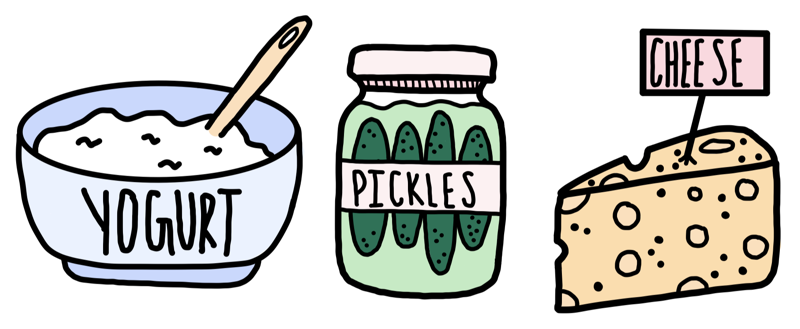 We are thrilled to welcome you to the latest edition of Nutrition Stories, a series exploring hot topics in nutrition and dietetics. Today’s guest is Emma Shutters, a graduate of the UF Didactic Program in Dietetics (DPD) in the Food Science and Human Nutrition program at The University of Florida. In this article, Emma describes the diverse world of the gut microbiome and how we can boost our health with probiotics and prebiotics.
We are thrilled to welcome you to the latest edition of Nutrition Stories, a series exploring hot topics in nutrition and dietetics. Today’s guest is Emma Shutters, a graduate of the UF Didactic Program in Dietetics (DPD) in the Food Science and Human Nutrition program at The University of Florida. In this article, Emma describes the diverse world of the gut microbiome and how we can boost our health with probiotics and prebiotics.
Emma: With approximately eight billion people in the world that call Earth their home, it’s fascinating that in just one person, there are nearly 100 trillion bacteria microbes inhabiting their gut.1 This staggering number of bacteria in each one of us play an essential role in keeping our body healthy. Similar as to how we rely on Earth’s natural resources to sustain life, the bacteria inside of our gut rely on us. The question is: how can we support the lives of our bacteria?
 The Cycle of Life
The Cycle of Life
The healthy bacteria in the gut works hard to protect the stomach and bowels from chronic gastrointestinal diseases, such as irritable bowel syndrome and inflammatory bowel diseases (including Crohn’s disease and ulcerative colitis), while also eliminating harmful bacteria that can cause inflammation in the bowels. Excessive gut inflammation increases the risk of gastrointestinal cancers, demonstrating the long-term impact of gut bacteria’s protective properties.2
What we put into our body determines the lifespan of our gut bacteria. Inflammatory foods such as fried foods, alcohol, and caffeine, along with prescribed antibiotics can cause damage to the healthy bacteria in our gut, causing a decrease in their population and jeopardizing our long-term gastrointestinal health.
For our own health, we should facilitate the health of our gut bacteria by incorporating two essential components into our diet: probiotics and prebiotics. Recent studies indicate that the consumption of probiotics and prebiotics that help maintain numbers of healthy bacteria in our gut can aid in the treatment of obesity and diabetes, as well as increasing the body’s ability to fight off infection.3
Probiotics: Our Gut’s Reproductive System
The first step in maintaining the health of your gut bacteria involves incorporating probiotics. Probiotics are defined as “live microorganisms that, when administered in adequate amounts, confer a health benefit on the host.”4 Fortunately for us, these ‘beneficial microorganisms’ are more accessible than you may think. Yogurts, cheese, fermented foods such as pickles, sauerkraut, and kimchi, as well as beverages such as kombucha are all good sources of probiotics. Additionally, foods fermented using yeast, such as sourdough, can also contribute to the growth of good bacteria in the gut. Incorporating these probiotic-rich foods into our diet can support the reproduction of a healthy balance of gut bacteria.
Daily consumption of probiotic-rich foods will allow for a healthy balance of bacteria in the gut, facilitating the reintroduction of good bacteria and preventing the overgrowth of harmful bacteria. Although foods such as kimchi and sauerkraut are rich sources of probiotics, incorporating them into the diet on a regular basis can be challenging. What are some easier ways to include probiotics in our typical diet?
Greek yogurt is a versatile and convenient option to add probiotics into meals. Plain Greek yogurt can be used as a substitute for sour cream in savory dishes or can be used as the base of a breakfast yogurt with your favorite toppings. Although there is no recommended daily allowance (RDA) for probiotics, its beneficial to add as many foods’ rich in probiotics as possible into your diet.
Now that we’ve begun incorporating probiotics into our diet and are actively assisting in the regrowth of healthy bacteria, what can we do to make sure that these new bacteria can thrive?
Prebiotics: The Food That Keeps on Giving
We now turn our attention to the second essential step in maintaining gut health: prebiotics. Prebiotics are defined as non-digestible (otherwise known as soluble) fibers that serve as fuel for the healthy bacteria in our gut.2 By continuing to nourish the bacteria we introduced through consuming probiotics, prebiotics will help promote their growth and stimulate their activity. Sources of prebiotics include bananas, garlic, asparagus, onions, whole grains rich in fiber, and many other fruits and vegetables.
So, what are some food swaps we can make in our diet to increase the number of prebiotics we eat daily? Remember the probiotic-rich Greek yogurt bowl we made for breakfast earlier? Add some sliced strawberries and bananas on top to sneak in some additional prebiotics, or a handful of whole grain granola. Like probiotics, prebiotics do not have a recommended daily allowance (RDA). However, foods rich in prebiotics are also rich in vitamins and minerals, therefore consuming them as often as possible is beneficial for not only your gut, but also your whole body.
Incorporating these prebiotic-rich foods into our meals will provide the essential nutrients that support a thriving ecosystem in our gut and ensure the continued health of our bacteria.
 Supplements or Sunshine?
Supplements or Sunshine?
Probiotic and prebiotic supplements have rapidly increased in popularity and can be bought over the counter in any supermarket. This begs the question: why try to incorporate probiotic and prebiotic-rich foods into my diet when I could just take a supplement each day?
For an analogy, let’s use our relationship with the sun. As humans, we need light to be able to see. Light can come from the sun, but it can also come from a lamp, television, or laptop. If we can use sources such as a lamp to see, what use do we have for the sun? Well, the UV light that comes from the sun allows our body to produce vitamin D, an essential vitamin required for long-term bone health. Although we can use a lamp to see, our lamp is unable to provide us with the additional benefits that the sun can provide. This same logic can be applied to probiotic and prebiotic supplements.
Although one of the benefits of consuming probiotic and prebiotic-rich foods is maintaining microbiotic health, they provide many additional benefits to the body that supplements cannot provide. These foods contain vitamins and minerals that aid in immunity, bone health, neurological health, growth, DNA synthesis, and many more biological functions that are required by the body. Furthermore, prebiotic rich foods are high in fiber, allowing for the regulating of bowel movements, hormone regulation, and appetite.5,6
[…] we need to be doing all we can to protect our bacteria, and by doing so, protect our own health.
In essence, while supplements may address specific concerns, incorporating probiotic and prebiotic-rich foods daily allows for a more holistic approach to health, providing many benefits that supplements alone cannot deliver.
An Example of a Probiotic- and Prebiotic-rich Meal Plan
Let’s consolidate our new knowledge and look at how a daily probiotic and prebiotic rich diet could look.
- Breakfast: You decide to make scrambled eggs with onions and peppers and a Greek yogurt bowl topped with strawberries, bananas, and granola.
- Lunch: You opt for a turkey and provolone sandwich on whole grain bread with pickles, pretzels, and raspberries on the side.
- Dinner: You end the day with a grilled chicken breast on top of a bed of quinoa and roasted asparagus.
Can you find where the probiotics and prebiotics are hidden? Probiotics can be found in the Greek yogurt, pickles, and provolone cheese, while prebiotics are found in the onions, granola, whole grain bread, strawberries, bananas, quinoa, and asparagus. Although it can seem overwhelming to add pre- and probiotics into your diet, these beneficial microbes are often times hidden in some of your favorite foods.
The important role that bacteria plays in our gut is extensive, and research is still being done to further discover everything bacteria can do. What remains clear, is that we need to be doing all we can to protect our bacteria, and by doing so, protect our own health. By incorporating probiotic and prebiotic-rich foods into our diet, we can continue to support the 100 trillion bacteria that call our gut their home.
Want to Learn More? Check Out These Resources.
- The microbiome. The Nutrition Source. July 25, 2022. Accessed March 27, 2024.
- Professional CC medical. What are probiotics & what do they do? Cleveland Clinic. Accessed March 27, 2024.
- Katherine Zeratsky RD. Probiotics and Prebiotics: What you should know. Mayo Clinic. July 2, 2022. Accessed March 27, 2024.
References

- Guinane CM, Cotter PD. Role of the gut microbiota in health and chronic gastrointestinal disease: Understanding a hidden metabolic organ. Therapeutic Advances in Gastroenterology. 2013;6(4):295-308. doi:10.1177/1756283×13482996
- Davani-Davari D, Negahdaripour M, Karimzadeh I, et al. Prebiotics: Definition, types, sources, mechanisms, and clinical applications. Foods. 2019;8(3):92. doi:10.3390/foods8030092
- Bodke H, Jogdand S. Role of probiotics in human health. Cureus. Published online November 9, 2022. doi:10.7759/cureus.31313
- Probiotics in food. Accessed March 27, 2024. https://www.fao.org/3/a0512e/a0512e.pdf
- Markowiak P, Śliżewska K. Effects of probiotics, prebiotics, and synbiotics on human health. Nutrients. 2017;9(9):1021. doi:10.3390/nu9091021
- You S, Ma Y, Yan B, et al. The promotion mechanism of prebiotics for probiotics: A Review. Frontiers in Nutrition. 2022;9. doi:10.3389/fnut.2022.1000517
Header photo credit: UF/IFAS Photo by Tyler Jones
Looking for more posts sharing stories about nutrition hot topics? Check out the rest of the UF/FSHN Nutrition Stories Series!
 6
6





